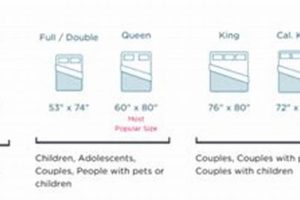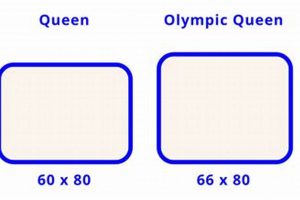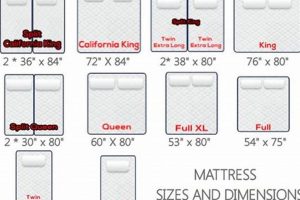Understanding the sizes of sleeping surfaces sold within the United Kingdom is crucial for consumers seeking appropriately sized bedding and ensuring compatibility with existing bedroom furniture. These measurements, typically expressed in centimeters or inches, dictate the internal dimensions of bed frames and the fit of sheets and mattress protectors. For example, a ‘single’ size is commonly around 90cm wide and 190cm long.
Accurate knowledge of these standard measurements offers several benefits. It simplifies the process of purchasing coordinating bedroom furnishings, prevents ill-fitting bedding, and allows for efficient space planning within a bedroom. Historically, these sizes have evolved alongside changes in housing design and average body size, leading to the introduction of variations such as small doubles and king sizes to accommodate different needs and preferences.
The following sections will delve into the specific measurements associated with each standard size, providing detailed information on single, small double, double, king, and super king options. Furthermore, considerations for non-standard or custom-made sleep surfaces will be addressed, offering guidance for individuals with unique requirements.
Selecting a correctly sized sleeping surface is paramount for optimal comfort and effective use of bedroom space. Adherence to the following guidelines ensures informed decision-making.
Tip 1: Measurement is Key: Always verify the dimensions of the bed frame before purchasing a mattress. Internal frame measurements should precisely match the stated sleeping surface size to prevent movement or damage.
Tip 2: Consider Room Size: Evaluate the available floor space. A larger option, such as a king or super king, may not be suitable for smaller rooms, impeding movement and visual appeal.
Tip 3: Sleeping Partners’ Needs: If sharing the bed, factor in the space requirements of both individuals. A larger option can minimize sleep disturbance and improve overall comfort levels.
Tip 4: Bedding Compatibility: Before purchase, consider the availability of suitably sized bedding. Non-standard sizes may necessitate custom-made sheets and duvets, increasing costs.
Tip 5: Access and Manoeuvrability: Assess the ease of transporting the sleeping surface into the bedroom. Large sizes may present difficulties navigating narrow doorways or staircases.
Tip 6: Future Considerations: Anticipate future changes in needs. A growing family or potential relocation may influence the long-term suitability of a chosen size.
Tip 7: Depth Awareness: Acknowledge mattress depth, as it influences bed height and aesthetic consistency in your bedroom.
These considerations promote a selection process grounded in practicality, guaranteeing satisfaction and long-term value.
The subsequent section will conclude the article with a comprehensive summary and final recommendations.
1. Standard Size Names
The nomenclature used to designate sleeping surface sizes within the United Kingdom directly relates to standardized measurements. These names serve as a shorthand, allowing consumers and manufacturers to communicate effectively about specific dimensions. Accurate interpretation of these designations is crucial for selecting a properly fitting product.
- Single
This term refers to the smallest standard size, typically intended for one individual. While variations exist, the approximate measurements are 90cm in width and 190cm in length. Misunderstanding this designation can lead to purchasing a surface too narrow for comfortable sleep or too short for adequate body support.
- Double
Signifying a size suitable for two adults, this option commonly measures around 135cm wide and 190cm long. Failure to recognize this dimension can result in cramped sleeping conditions, especially if both occupants require ample personal space.
- King
Larger than a double, this term denotes a surface usually 150cm wide and 200cm long. It offers increased space for couples or individuals who prefer a wider sleeping area. Ignoring the distinction between ‘double’ and ‘king’ sizes will lead to selecting an inappropriately sized product.
- Super King
Representing the largest standard option readily available, this size typically measures 180cm wide and 200cm long. Providing maximum space for two individuals, it is crucial to differentiate this from the ‘king’ size to avoid underestimating the necessary bedroom space or overspending on smaller bedding.
In summary, the terminology associated with sleeping surface dimensions in the UK is inextricably linked to precise measurements. Understanding these terms and their corresponding dimensions is paramount for making informed purchasing decisions and ensuring compatibility with existing or planned bedroom furniture and bedding.
2. Length and Width (cm)
The length and width, measured in centimeters, are fundamental components defining the overall size of a sleeping surface marketed in the United Kingdom. These two dimensions dictate the usable area of the mattress and directly influence its suitability for accommodating individuals or couples. For example, a standard single sleeping surface measures approximately 90cm in width and 190cm in length. If either of these measurements deviates significantly, the designation as a standard ‘single’ would be inaccurate and potentially misleading to consumers.
The precision of length and width measurements is critical for compatibility with UK bed frames. Bed frames are manufactured to accommodate specific sleeping surface sizes, and discrepancies can lead to instability, reduced support, and accelerated wear. Consider a scenario where a bed frame designed for a standard double (135cm x 190cm) is fitted with a sleeping surface that is slightly undersized. This can result in movement during sleep, potentially damaging both the surface and the frame. Conversely, an oversized option may not fit within the frame at all, rendering it unusable.
In conclusion, the length and width, quantified in centimeters, are intrinsic to the classification and functional performance of UK sleeping surfaces. Understanding these measurements is essential for informed purchasing decisions, ensuring compatibility with existing furniture, and maximizing user comfort and support. Inconsistencies can lead to practical challenges and financial implications, underscoring the importance of accurate measurement and adherence to standardized dimensions.
3. Depth variations
Depth variations, while often overlooked, constitute an integral component of “mattress dimensions uk”. The stated length and width provide the planar dimensions, but the depth dictates the overall volume and impacts both comfort and compatibility with bedding and bed frames. These variations arise from differing internal constructions, utilizing varying densities and arrangements of materials such as springs, foam, and fibers. A thicker option, for example, might incorporate multiple layers of memory foam for enhanced pressure relief, leading to a greater overall depth compared to a simpler innerspring design. Failure to account for these depth variations can lead to purchasing sheets that do not adequately fit or bed frames where the sleeping surface sits too high or too low.
The practical significance of understanding depth variations is exemplified in the selection of bed frames with headboards. A particularly thick sleeping surface may partially obscure the headboard, diminishing its aesthetic appeal and potentially impacting support. Conversely, a very thin option within a deep bed frame may leave an unappealing gap. Furthermore, some adjustable bed bases have limitations regarding maximum depth. For example, a frame rated for a maximum depth of 30cm may be incompatible with a 35cm deep sleeping surface, potentially voiding warranties or causing damage to the frame’s mechanism. Similarly, children’s beds often have depth limitations for safety reasons, to prevent children from climbing over the safety rails.
In conclusion, depth variations represent a critical, yet often neglected, aspect of “mattress dimensions uk.” Accurate assessment of depth is necessary for ensuring compatibility with existing bedroom furniture, achieving the desired aesthetic, and maximizing comfort. Ignoring depth variations can lead to practical challenges, diminished comfort, and potential financial implications, highlighting the importance of considering this dimension alongside length and width during the selection process.
4. Frame compatibility
Frame compatibility is inextricably linked to “mattress dimensions uk”, directly influencing the support, stability, and overall functionality of a bed system. Accurate matching of these elements is crucial for optimal sleep quality and longevity of both the sleeping surface and frame.
- Internal Dimensions
Internal frame dimensions must precisely accommodate the stated length and width of the mattress. A discrepancy, even a few centimeters, can lead to inadequate support, causing sagging, uneven weight distribution, and premature wear. For example, a standard double sleeping surface (135cm x 190cm) placed within a frame designed for a king (150cm x 200cm) will lack edge support and exhibit instability.
- Slat Spacing and Support
Slat spacing impacts the distribution of weight across the surface. Excessive gaps between slats can result in localized pressure points and reduced support, particularly for heavier individuals or heavier sleeping surfaces. A frame with widely spaced slats may not be compatible with a memory foam option, which requires consistent, uniform support to prevent deformation.
- Frame Height and Headboard Compatibility
Frame height, in conjunction with the sleeping surface depth, affects the overall bed height. This is crucial for ease of access and aesthetic considerations, particularly concerning headboard visibility. A deep sleeping surface atop a high frame can obscure the headboard, while a shallow sleeping surface on a low frame may make the bed difficult to enter and exit.
- Weight Capacity
Frames possess specific weight capacities that must not be exceeded by the combined weight of the sleeping surface and occupants. Overloading a frame can compromise its structural integrity, leading to breakage, instability, and potential injury. Lightweight metal frames, for instance, may be unsuitable for particularly heavy latex or hybrid options, especially when supporting two adults.
These considerations highlight the vital connection between frame compatibility and “mattress dimensions uk”. Precise matching of dimensions, appropriate slat spacing, consideration of frame height, and adherence to weight capacity guidelines ensure optimal performance and longevity of the entire bed system, directly impacting sleep quality and overall user satisfaction.
5. Bespoke options
Bespoke sleeping surfaces, while deviating from standardized sizes, maintain a direct relationship with “mattress dimensions uk”. These custom-made options address specific needs not met by conventional offerings, requiring meticulous attention to dimensional specifications to ensure both comfort and practicality.
- Non-Standard Room Sizes
Architectural peculiarities or space limitations sometimes necessitate sleeping surfaces of atypical dimensions. A loft conversion with a sloping ceiling, for instance, might require a trapezoidal or unusually short sleeping surface to maximize usable space. These bespoke solutions must adhere to precise measurements to ensure a snug fit and prevent wasted space.
- Medical Requirements
Individuals with specific medical conditions may require sleeping surfaces of unusual dimensions or shapes to accommodate specialized support systems or therapeutic devices. A patient recovering from surgery might require an oversized or multi-zoned sleeping surface to alleviate pressure points and promote healing. These bespoke options are dictated by medical needs, superseding standard “mattress dimensions uk”.
- Antique Bed Frames
Antique bed frames often predate modern standardization of sleeping surface sizes. Fitting a modern sleeping surface into an antique frame may require custom dimensions to ensure a secure and aesthetically pleasing fit. The internal measurements of the antique frame dictate the bespoke dimensions of the required sleeping surface.
- Unique Comfort Preferences
While less common, some individuals may prefer sleeping surfaces of unusual dimensions based purely on personal preference. An exceptionally tall individual, for example, might require a significantly longer sleeping surface than standard offerings provide. These bespoke dimensions prioritize individual comfort, diverging from conventional “mattress dimensions uk” to meet specific needs.
These examples illustrate that bespoke sleeping surfaces, while falling outside the realm of standard “mattress dimensions uk”, remain fundamentally defined by dimensional specifications. Whether driven by spatial constraints, medical requirements, historical context, or personal preference, accurate measurement and meticulous construction are paramount to ensure functionality and user satisfaction.
Frequently Asked Questions Regarding Mattress Dimensions in the UK
This section addresses common inquiries concerning the standardization and practical implications of sleeping surface measurements within the United Kingdom.
Question 1: Are mattress dimensions in the UK standardized?
While industry standards exist, slight variations may occur between manufacturers. It is crucial to verify specific measurements before purchasing.
Question 2: How are sleeping surface dimensions typically expressed in the UK?
Measurements are predominantly expressed in centimeters (cm), although inches are occasionally used, particularly when referencing imperial sizes.
Question 3: What constitutes a ‘small double’ sleeping surface?
A small double typically measures approximately 120cm in width and 190cm in length, falling between a single and a standard double size.
Question 4: Do mattress depths vary significantly?
Yes, depths vary depending on construction and materials. This dimension impacts bed height and sheet fit, and therefore should be carefully considered.
Question 5: What should be done if standard sizes are unsuitable?
Bespoke or custom-made options are available to accommodate unique spatial requirements or specific medical needs.
Question 6: How does incorrect matching of the sleeping surface to the bed frame affect its useful life?
Inaccurate matching may cause uneven wear, reduced support, and premature degradation of both the sleeping surface and the bed frame.
Accurate dimensional assessment is essential for ensuring compatibility, comfort, and longevity of sleeping surfaces. Failure to consider these aspects may result in dissatisfaction and unnecessary expense.
The following section will summarize the key considerations presented throughout this article, providing a concise overview of “mattress dimensions uk” and their implications for consumers.
Mattress Dimensions UK
This exploration of “mattress dimensions uk” has underscored the critical importance of accurate measurement and standardized sizing within the United Kingdom’s bedding market. The information presented has detailed standard size designations, emphasized the practical implications of length, width, and depth variations, and addressed the necessity of frame compatibility. The discussion also encompassed the availability and relevance of bespoke options for specialized needs. The points detailed should assist in ensuring compatibility, comfort, and longevity, avoiding any potential problems.
Ultimately, informed decision-making regarding “mattress dimensions uk” translates to enhanced sleep quality, optimized space utilization, and avoidance of unnecessary expense. Continued diligence in verifying dimensional specifications and awareness of evolving industry standards are crucial for consumers seeking to invest wisely in their sleep environment. Prioritizing dimension during the selection process contributes to a satisfactory and long-lasting bedding solution.







